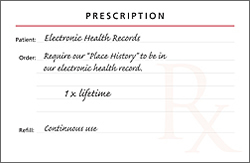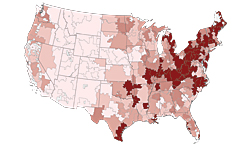ArcUser Online
In his presentation Can Geographic Information Keep You Healthy? Davenhall suggested that a patient's geographic (or place) history should routinely be considered by physicians when diagnosing and treating patients. There is abundant evidence that the use of GIS has dramatically impacted the public health. Medical epidemiologists have extensively used GIS to establish the relationships between person, place, and time as these factors pertain to disease outbreaks. GIS has also been used by public health officials to protect communities from otherwise overlooked risks and toxic exposures. However, the geographic component has been remarkably absent from the treatment of individual patients. For individuals, health risk factors can be expressed by a simple formula: Genetics + Lifestyle + Environment = Risks. Patient histories focus on the first two factors but completely ignore the last. When taking a patient's medical history, questions deal with the health and medical conditions of a patient's relatives (genetics) and the patient's personal habits (lifestyle) but nothing is asked about where the patient lives or has lived. Davenhall observed that a great deal of research has been invested in relating what happens in the environment to human health but "this information is not used in a direct way by your doctor." Geospatial technologies have the potential to help diagnose, treat, and, in some cases, prevent illness. The emerging field of geospatial medicine, or geomedicine, could generate a type of medical intelligence that leverages national spatial data infrastructures to the benefit of personal human health. The key to delivering geospatial intelligence to health care professionals requires capturing and accessing information about where a patient lives and has lived—that patient's place history. The widespread use of geospatial technologies is making capturing this information increasingly easy. The ubiquity of the Internet makes accessing this information from virtually anywhere equally simple. During his presentation, Davenhall demonstrated a simple application developed for the iPhone for collecting a personal place history. This information could be shared with medical personnel when necessary. This patient itinerary could be used to unlock everything known about the places that person has lived in or visited—the air, water, ground, food, culture, demographic characteristics, and other factors that can affect well-being. According to Davenhall, where a person lives and works "has everything to do with the quality of your health." He used his own life's journey to illustrate this assertion. For the first 18 years, Davenhall lived in Scranton, Pennsylvania, a place that has been designated by the Environmental Protection Agency seven times in the past 20 years as the most polluted environment in terms of sulfur dioxide, carbon dioxide, and methane gas emissions. His home for the next 25 years was Louisville, Kentucky, an area known for the production of polyvinyl chloride products, such as PVC pipe, and all kinds of plastics that require chloroprene and benzene for their production. These substances cause conditions such as leukemia, brain cancers, and central nervous system disorders. California, Davenhall's most recent home, suffers from pollution caused by particulate matter, carbon dioxide, and ozone. After considering his place history, Davenhall realized that he had—quite unintentionally—managed to live in some of the most polluted areas in the United States. When he looked at maps produced by the National Institutes of Health showing areas in the United States where people are most likely to have heart attacks, he discovered that if he had wanted to have a heart attack, he had lived in exactly the right places. These places, symbolized in red, were where inhabitants are exposed to conditions or environmental triggers that can cause a heart attack. However, all this relevant and vital information was missing from his medical record. Not only was there no place for place history in his record but his physicians wouldn't have known how to use it if it had existed. Currently, medical students typically aren't exposed to a curriculum that would help them make these kinds of connections. As Davenhall noted, place history doesn't supply cause and effect because, "For most of the problems we have as humans walking around this planet, there will never be a strong cause and effect. But there will be a lot of correlation and a lot of association." He offered two prescriptions to improve this situation. First, physicians need to understand the importance of geomedicine and that will be accomplished through funding geomedical curriculum in schools. Loma Linda University in Southern California has been a pioneer in this area and recently opened the Health Geoinformatics Laboratory center. (See the accompanying article, "Designing Healthy Communities: Health Geoinformatics Laboratory opens.") His second prescription is to make a space for history in the electronic health records systems that are being developed. "So I always now say geography does matter. It matters to me. I know it personally," noted Davenhall. "And I would hope that all of you could see that GIS is a technology and information that can keep you healthy." |

